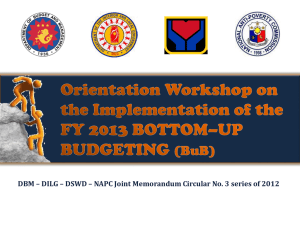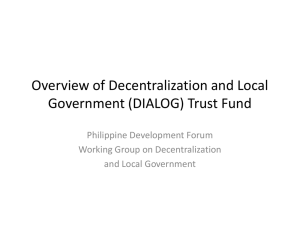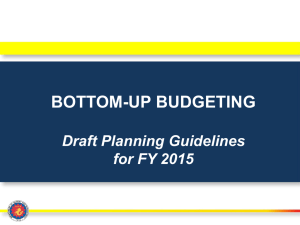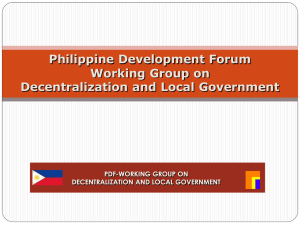DBM - GACPA Home Page
advertisement
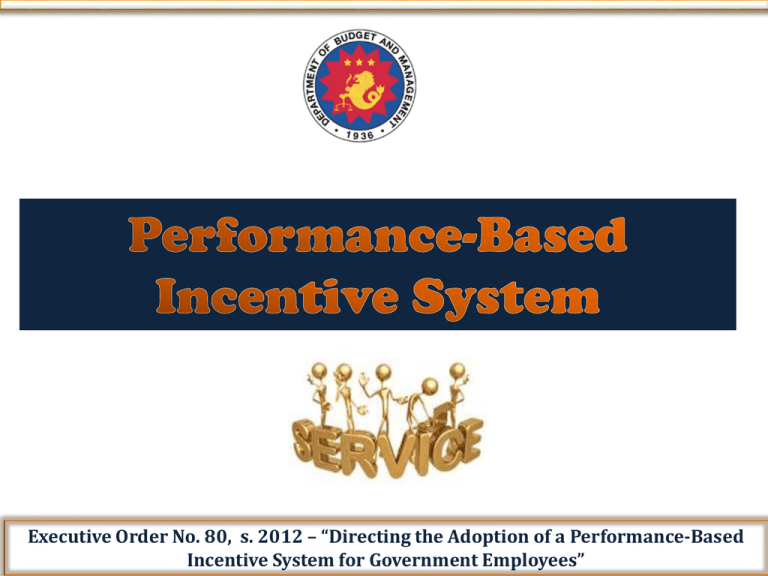
Executive Order No. 80, s. 2012 – “Directing the Adoption of a Performance-Based Incentive System for Government Employees” What existing incentive system do we have now? - No distinction between the NPAs and PAs - Everybody is rewarded/Across-the-board bonus - Reward becomes a disincentive for good performers or PERFORMING ASSETS (PAs) - Culture of mediocrity is being propagated Executive Order No. 80, s. 2012 Need to come up with a fair incentive system: / Rationalize the current incentive system /Strengthen performance monitoring and appraisal system based on existing systems like the OPIF, Strategic Performance Management System of CSC, and the RBPMS / Improve service delivery by the bureaucracy by linking personnel incentives to the bureau or delivery unit’s performance Executive Order No. 80, s. 2012 1. Productivity Enhancement Incentive • P5,000 across-the-board 2. Perfomance-Based Bonus (PBB) • Top-up Bonus for personnel of bureaus or delivery units based on their contribution to the accomplishment of their Department’s overall targets and commitments Executive Order No. 80, s. 2012 Strategies in Adopting the PBB •Flexibility shall be given to heads of departments to suit the PBB system to the nature of their operations •Adoption of a communications strategy and publication of performance targets and accomplishments in the website to ensure transparency and accountability Executive Order No. 80, s. 2012 Criteria and Conditions to Qualify for PBB Achieved at least 90% of MFO targets and Priority Program targets agreed with the President under the five (5) Key Result Areas of EO 43; Meet 2 to 3 good governance conditions/ requirements set by the AO 25 Task Force annually under the performance drivers of the RBPMS; a. Financial stewardship - mandatory posting of budget reports (Agency Transparency Seal); posting of all invitations to bid and awarded contracts in the PHILGEPS; and liquidation of all cash advances for the year within the reglementary period b. Internal process efficiency - establishment of a Citizen’s Charter or its equivalent Bureaus within the Department meeting above conditions are forced ranked and their respective personnel. Executive Order No. 80, s. 2012 Performance Categories 1. Department Secretaries shall rank the bureaus or delivery units, including attached agencies, according to their performance following a normal distribution curve. Bureaus/Delivery Units Distribution Rating 10% Best 25% Better 50% Good 15% Poor Executive Order No. 80, s. 2012 Performance Categories 2. For 2012, the Bureau Heads shall rate employees using their respective Performance Appraisal Systems Personnel within the Bureaus/Delivery Units Distribution 10% 25% Rating Best Better 65% Good Executive Order No. 80, s. 2012 PBB Distribution No PBB for “POOR” bureaus that did not meet 90% of targets (Remaining 15% of ranked bureaus) PBB for “GOOD” bureaus (Next 50% of ranked bureaus) P5,000 P5,000 PBB for “BETTER” bureaus (Next 25% of ranked bureaus) P35,000 P25,000 P15,000 PBB for “BEST” bureaus (Top 10% of ranked bureaus) (max) PBB P5,000 PEI (max) (max) P5,000 No PBB for Bureaus whose accomplishment is less than 90% of targets 9 PBB Rates of Incentives Bureau Category Individual Category Best Performer Better Performer Good Performer Best Bureau 35,000 20,000 10,000 Better Bureau 25,000 13,500 7,000 Good Bureau 15,000 10,000 5,000 Executive Order No. 80, s. 2012 Coverage All Departments/Agencies, other Offices of the National Government, State Universities and Colleges (SUCs), and Government-Owned orControlled Corporations (GOCCs) are covered. The Governance Commission on GOCCs (GCG) is encouraged to adopt the policies and principles in the EO and issue guidelines for GOCCs covered under RA 10149, pending formulation of a compensation system for GOCCs. Executive Order No. 80, s. 2012 Funding for PBB The PEI and PBB top-up bonus shall be sourced from the Miscellaneous Personnel Benefits Fund (MPBF) For GOCCs, the same shall be sourced from their corporate funds Executive Order No. 80, s. 2012 2012 Implementation Schedule Executive Briefings/ Orientations Cascading Workshops with Agencies Consultation/ Coaching of Agencies (July 2012) (July 2012) (July 2012) Submission of Accomplishment Reports Review/Approval of Agency Performance Targets Submission of Cascaded Performance Targets (1st week of December 2012) Evaluation of Performance (2nd week of December 2012) (September 2012) Grant of Bonus (4th week of December 2012) Executive Order No. 80, s. 2012 (August 2012) Phases of PBB Implementation FY 2014 FY 2015 FY 2013 3rd-4th Q 2012 2nd to 3rd Q 2012 Institutionalization Stabilization Refinement & Harmonization Pilot implementation Setting the preconditions Executive Order No. 80, s. 2012 Executive Order No. 80, s. 2012 MEMO CIRCULAR NO. 2012-05 DATED JANUARY 14, 2013…….1/8 • GUIDELINES TO CLARIFY THE ELIGIBILITY AND RANKING OF PERSONNEL IN LINE WITH THE GRANT OF PERFORMANCE-BASED BONUS FOR FY 2012… a) The personnel are still in the service as of November 30, 2012 and have rendered at least four (4) months of service as of said date; GUIDELINES….. 2/8 b) Employees belonging to the 1st & 2nd levels should receive a rating of at least “SATISFACTORY” under the CSC-approved Performance Appraisal System (PAS); c) Officials at the 3rd level should receive a rating of at least “VERY SATISFACTORY” under the Career Executive Service Performance Evaluation System (CESPES). Payment of the PBB to them shall be based on the results of the CESPES; GUIDELINES… 3/8 d) Other Officials not covered by the CESPES should receive a rating of at least “SATISFACTORY” under the existing Performance Appraisal System of the Department/Agency; e) The contractual and casual personnel who may be entitled to the PBB shall be those whose compensation are charged to the lump sum appropriation under Personal Services; GUIDELINES….. 4/8 • …or those occupying positions in the DBMapproved contractual staffing pattern of agencies concerned. They may be included in the ranking along with the regular personnel; f) Personnel on detail to another government agency for three (3) months or more as of November 30, 2012 shall be included in the ranking of employees in the recipient agency which rated his/her performance; GUIDELINES…. 5/8 g) Personnel on scholarship may be included in the ranking, provided they qualify based on the performance criteria established by the Performance Management Group (PMG) and approved by the Agency Head; h) The PBB of employees on part-time basis shall be pro-rated corresponding to the services rendered; GUIDELINES… i) 6/8 Personnel found guilty of administrative and/or criminal cases filed against them and METED PENALTY IN FY 2012 shall not be entitled to the FY 2012 PBB. If the penalty meted out is only a REPRIMAND, such penalty shall not cause the disqualification to the PBB; j) The Office of the Secretary (OSEC) in a Department or an equivalent unit in a Department-level agencies shall be considered as one (1) delivery unit to include the OSEC itself and …. GUIDELINES… 7/8 ….all the Offices of the Department Undersecretaries and Assistant Secretaries. All officials and employees within OSEC shall be ranked accordingly; k) The Third Level officials within the bureaus/offices/delivery units (such as the Bureau Directors and Assistant Directors) may be ranked in either of two (2) ways, …… GUIDELINES….. 8/8 ….SUBJECT TO THE RECOMMENDATION OF THE PERFORMANCE MANAGEMENT GROUP (PMG) and approval of the Agency Head: k.1 Include said officials in the ranking of personnel within each bureau/ office /delivery unit; or k.2 Include said officials in the ranking of personnel within OSEC. OTHER REQUIREMENTS 1. For proper review, attached agencies/offices are reminded to submit their PBB compliance requirements to their respective MOTHER DEPARTMENTS, which shall in turn consolidate and submit said reports to their respective Budget & Management Bureau, DBM. 2. To facilitate validation of the PhilGeps posting, Departments/Agencies are requested to indicate the Reference Number of the Invitations to Bid and the Project Title consistent with the number and title posted in the PhilGeps. Other requirements.. CITIZEN’S CHARTER…1/3 3.To facilitate the validation of Citizen’s Charter, Departments/Agencies should ensure compliance with Section 6 of the Anti-Red Tape Act of 2007 and Rule IV of its Implementing Rules and Regulations: a) The service standards known as the Citizen’s Charter enumerating the following was established: CITIZEN’S CHARTER ….2/3 i. Vision and Mission of the Agency ii. Frontline services offered iii. Step-by-step procedure in availing of frontline services iv. Employee responsible for each step v. Time needed to complete the procedure vi. Amount of fees (for a collecting agency) vii. Required documents viii. Procedure for filing complaints CITIZEN’S CHARTER…3/3 b) The Citizen’s Charter is posted as information billboards in all the service offices of the department/agency that deliver frontline services. c) The Citizen’s Charter is positioned at the main entrance of the office or at the most conspicuous place of all the said service offices. d) The Citizen’s Charter is published, written either in English, Filipino, or in local dialect. THANK YOU SO MUCH FOR LISTENING • HOPE YOU BELONG TO THE BEST DEPARTMENT/ BUREAU/ DELIVERY UNIT… • GOOD LUCK! ! ! DBM – DILG – DSWD – NAPC Joint Memorandum Circular No. 3, series of 2012 December 20, 2012 PURPOSE: To provide participating agencies and LGUs with policy guidelines, processes, responsibilities and timelines in the bottom-up budgeting approach to be applied in the preparation of the FY 2014 National Expenditure Program DBM – DILG – DSWD – NAPC Joint Memorandum Circular No. 3, series of 2012, December 20, 2012 DEFINITION: An approach to preparing the budget proposal of agencies, taking into consideration the development needs of poor cities / municipalities as identified in their respective local poverty reduction action plans that shall be formulated with strong participation of basic sectors and civil society organizations. DBM – DILG – DSWD – NAPC Joint Memorandum Circular No. 3, series of 2012, December 20, 2012 KEY PLAYERS: LGU LCE Local Poverty Reduction Action Team Local Sanggunian Civil Society/Basic Sector Organizations Regional Poverty Reduction Action Team Regional Offices of Participating NGAs National Bottom-Up Poverty Reduction Team Agency Central Offices HDPRC DBM – DILG – DSWD – NAPC Joint Memorandum Circular No. 3, series of 2012, December 20, 2012 PARTICIPATING AGENCIES: DA, DAR, DEPED, DOE, DENR, DOH, DILG, DSWD, DOLE, DOT, DTI, TESDA and NEA COORDINATION & OVERSIGHT AGENCIES: DBM, DILG, DSWD, NAPC and NEDA DBM – DILG – DSWD – NAPC Joint Memorandum Circular No. 3, series of 2012, December 20, 2012 The Regional Poverty Reduction Action Team: Chair : DILG Regional Director Vice-Chair : DBM Regional Director Members : -Regional Directors of DA, DAR, DENR, DOH, DEPED, DOLE, DSWD, DTI, DOT, TESDA & NEDA -Representatives of DOE & NEA -A CSO Representative per province as identified by NAPC DBM – DILG – DSWD – NAPC Joint Memorandum Circular No. 3, series of 2012, December 20, 2012 The Local Poverty Reduction Action Team: Chair Co-Chair Members : Local Chief Executive : A CSO Representative : Representatives from: Non-government - 50% of total number Government - 50% -------100% Notes: At least 40% of total number shall be women. CSO representative must be resident of the city/municipality DBM – DILG – DSWD – NAPC Joint Memorandum Circular No. 3, series of 2012, December 20, 2012 Local Poverty Reduction Action Team Members: Government Chairperson of Committee on Appropriations- Local Sanggunian All Local Government Department Heads Representatives from NGAs such as DSWD Municipal Links, C/MLGOO, School District Supervisor, Agency Regional Offices Non-Government Pantawid Pamilya Parent-Leader Leader from DOH organized community health teams Leader of PTA, women’s group, basic sector organizations grassroots organizations CSO accredited by the LGU CSO accredited by any NGA DBM – DILG – DSWD – NAPC Joint Memorandum Circular No. 3 series of 2012 dated December 20, 2012 Coverage CY 2013 CY 2014 Nationwide CAR 609 LGUs 37 LGUs 1,233 LGUs 54 LGUs From 609 LGUs to 1,233 LGUs DBM – DILG – DSWD – NAPC Joint Memorandum Circular No. 3 series of 2012 dated December 20, 2012 selected based on the: Poverty incidence of at least 20% & poor population of at least 5000 individuals based on the 2009 Small Area Estimates (NSCB) and 2010 census data high economic potential areas exposure to high geo-hazard risk such as floods and landslides as identified by MGB DBM – DILG – DSWD – NAPC Joint Memorandum Circular No. 3 series of 2012 dated December 20, 2012 38 Abra (18) Bangued, Boliney, Bucay, Bucloc, Daguioman, Dolores, La Paz, Lacub, Lagangilang, Licuan-Baay, Luba, Malibcong, Pidigan, Pilar, Sallapadan, San Juan, Tayum, Tubo Baguio City (1) Apayao (4) Conner, Luna, Kabugao, Pudtol Benguet (9) Atok, Bakun, Buguias, Kabayan, Kapangan, Kibungan, Mankayan, Tuba, Tublay DBM – DILG – DSWD – NAPC Joint Memorandum Circular No. 3 series of 2012 dated December 20, 2012 Kalinga (7) Balbalan, Lubuagan, Pasil, Pinukpuk, Tabuk City, Tanudan, Tinglayan Ifugao (9) Aguinaldo, Alfonso Lista(Potia), Asipulo, Banaue, Hingyon, Hungduan, Lamut, Mayoyao Mt. Province Bauko, Bontoc, Paracelis, (6) Sadanga, Sagada, Tadian DBM – DILG – DSWD – NAPC Joint Memorandum Circular No. 3 series of 2012 dated December 20, 2012 EMPOWERMENT PROCESS & BOTTOM-UP BUDGETING PROCEDURES: 1. Preparation for poverty reduction planning and budgeting NAPC & DILG organize capacity building activities on constructive engagement & participatory planning & budgeting for CSOs & LGUs in coordination with RPRATS: Conduct of city/municipal Civil Society Assemblies CSOs to identify and agree on a set of priority poverty reduction projects and measures that reflect grassroots community issues and demands, which they will advocate for inclusion in the LPRAP. DBM – DILG – DSWD – NAPC Joint Memorandum Circular No. 3, series of 2012, December 20, 2012 EMPOWERMENT PROCESS & BOTTOM-UP BUDGETING PROCEDURES: 1. Preparation for poverty reduction planning and budgeting Selection of LPRAT co-chairperson & CSO signatories of the LPRAP Elected CSO representatives will elect among themselves the cochair of the LPRAT & the three representatives who will sign the LPRAP that must include: A Pantawid Pamilya parent leader (if the LGU has no PP beneficiaries, a Parent Teacher Association representative can serve as alternative); A representative from a basic sector organization or cooperative (farmers & landless rural workers, artisanal fisherfolk, formal labor & migrant workers, workers in the informal sector, indigenous peoples & cultural communities, women, persons with disabilities, senior citizens, victims of calamities & disasters, youth & students, children, or urban poor A third CSO representative who is a member of the city or municipal local development council DBM – DILG – DSWD – NAPC Joint Memorandum Circular No. 3, series of 2012, December 20, 2012 EMPOWERMENT PROCESS & BOTTOM-UP BUDGETING PROCEDURES: 1. Preparation for poverty reduction planning and budgeting Updating of & validation of relevant economic & social data LGUs to consolidate & update relevant information, statistics, and sex-disaggregated data for poverty reduction planning Sources of Data: Community-Based Monitoring System (CBMS), Field Health Service Information System (FHSIS), Socio-Economic Profile, Social Protection & Dev’t Report, Operation Timbang Data, School Improvement Plans, administrative records of NGAs, National Household Targeting System; Participatory Situational Analysis Result (for Kalahi-CIDDS areas), & data from electric cooperatives on sitio & household electrification projects, etc. DBM – DILG – DSWD – NAPC Joint Memorandum Circular No. 3, series of 2012, December 20, 2012 EMPOWERMENT PROCESS & BOTTOM-UP BUDGETING PROCEDURES: 2. Conduct of LPRAP Workshop Conducted to formulate a Local Poverty Reduction Action Plan (LPRAP); taking into account relevant sections of the Comprehensive Development Plan (CDP), Comprehensive Land Use Plan (CLUP), Executive Legislative Agenda (ELA), & the Annual Investment Program (AIP) With active participation of CSOs, BSOs & other non-government stakeholders With technical assistance from the RPRAT DBM – DILG – DSWD – NAPC Joint Memorandum Circular No. 3, series of 2012, December 20, 2012 EMPOWERMENT PROCESS & BOTTOM-UP BUDGETING PROCEDURES: 2. Conduct of LPRAP Workshop The LPRAP shall identify the poverty reduction strategy to be undertaken by the LGU and other stakeholders through a vote among its members using clear criteria and a transparent & participatory process incorporating good governance, gender mainstreaming and climate change mitigation/adaptation strategies using the format in Annex B DBM – DILG – DSWD – NAPC Joint Memorandum Circular No. 3, series of 2012, December 20, 2012 EMPOWERMENT PROCESS & BOTTOM-UP BUDGETING PROCEDURES: All Poverty Reduction Projects must contribute to the following national government priorities: Provision of Basic Social Services & Attainment of the Millenium Development Goals, including poverty reduction; Hunger Mitigation and Elimination; Job Generation & Inclusive Local Economic Development; and Climate Change Adaptation/Mitigation and Disaster Preparedness. o Localities that experience a high prevalence of hunger shall include hunger mitigation/elimination programs o Localities that are situated in geohazard areas shall include disaster risk reduction/climate change adaptation programs DBM – DILG – DSWD – NAPC Joint Memorandum Circular No. 3, series of 2012, December 20, 2012 Department of -Farm to Market Roads -Small Irrigation Projects Agriculture -Communal Irrigation Systems -National Rice Program -National Corn Program -National High Value Crops Program -National Fisheries Program -Promotion and development of organic production (More info to be provided by DA-CAR) Department of Communal Irrigation Systems, Roads, Agrarian Bridges, School Buildings, Day Care Centers, Reform Flood Control Projects (More info to be given by DAR CAR) DOE Household Electrification Program (HEP) NEA On Grid-Sitio Electrification Program (SEP) • Basic Education Facilities -Repair/Rehabilitation of classrooms -Construction of Water and Sanitation Facilities • Gulayan sa Paaralan • Innovative programs to promote access to Education National Greening Program (More info to be provided by DENR-CAR) DepEd DENR DOH • Epidemiology & Disease Surveillance • Maternal neonatal, child health and nutrition (MNCHN) • Community Health Team (CHT) mobilization • Infectious Diseases • Health Emergency Management • Doctors to the Barrios • RNheals • Rural Health Training & Placement Program • Health Facilities Enhancement Program • Geographically Isolated and Disadvantaged Areas • Others (Vitamins, Vaccines, Complete Treatment Pack) DILG Provision for Potable Water Supply (More info to be provided by DILG-CAR) DSWD • Kapit-Bisig Laban sa Kahirapan – Comprehensive and Integrated Delivery of Social Service (KALAHI-CIDSS) Project • Sustainable Livelihood Program • Social Pension for Indigent Senior Citizens • Supplementary Feeding Program • Core Shelter Assistance Program • Child and Youth Welfare Program • Women Welfare Program • Program for Persons with Disabilities • Family Welfare Program DTI • Shared Service Facility (SSF) • One Town One Product (OTOP) Stores – Ang Tindahang Pinoy • Bamboo Development Project • Philippine Traceability for Revitalized Agricultural Competitiveness Enhancement (P-Trace) Project • Production Innovation Program (PIP) • Rural Microenterprise Promotion Program (RuMEPP) • Business Permit and Licensing Systems (BPLS) DOT TESDA Local Tourism Development Projects (More info to be provided by DOT-CAR) • Tech-Voc Training • Community-Based Training (More info to be provided by TESDA-CAR) Projects NOT to be proposed as BuB Projects: o Expansion of Pantawid Pamilya Program beneficiaries (since identification o o o o thereof is done thru NHTS); Housing projects (due to substantial cost requirement); Major flood control projects (due to huge cost requirement); Vaccination program (since universal coverage is already provided by DOH & PHIC); National Health Insurance Program (since coverage for indigents is already provided by PHIC); o Projects related to law enforcement, fire protection and jail management (not poverty reduction projects); o Construction of city/municipal hall & other multi-purpose buildings, procurement of furniture and fixtures (not poverty reduction projects); o Construction of new schools buildings and classrooms, and teacher deployment (already provided in the FY 2013 National Budget); o Purchase of motor vehicles (i.e. ambulances, trucks, fire trucks); and o International trainings/scholarships. DBM – DILG – DSWD – NAPC Joint Memorandum Circular No. 3, series of 2012, December 20, 2012 In identifying priority poverty reduction projects: LGUs must allocate 80% of their budget cap for projects which are already being undertaken by partner NGAs (Based on Menu of Projects – Annex C of JMC No. 3, s. 2012) The remaining 20% of their budget cap may be allocated for new programs proposed by the LPRAT (Based on national government priorities - 5.2.8 of JMC No. 3, s. 2012) Funding shall not exceed the cap set for each city or municipality (Annex A of JMC No. 3, s. 2012) Lists of priority projects which exceed the cap set for the LGU will no longer be entertained by the participating NGAs and the HDPRC DBM – DILG – DSWD – NAPC Joint Memorandum Circular No. 3, series of 2012, December 20, 2012 EMPOWERMENT PROCESS & BOTTOM-UP BUDGETING PROCEDURES: 3. Endorsement of CSOs A Pantawid Pamilya parent leader A representative from a basic sector organization or cooperative A CSO representative who is a member of the city or municipal local development council all three must sign and endorse the list of priority projects DBM – DILG – DSWD – NAPC Joint Memorandum Circular No. 3, series of 2012, December 20, 2012 EMPOWERMENT PROCESS & BOTTOM-UP BUDGETING PROCEDURES: 4. Adoption of priority projects by the Sanggunian Sanggunian must also adopt the list of priority projects before it is submitted to the national government; Through the issuance of a Sanggunian Resolution using the prescribed format (Annex D); DBM – DILG – DSWD – NAPC Joint Memorandum Circular No. 3, series of 2012, December 20, 2012 EMPOWERMENT PROCESS & BOTTOM-UP BUDGETING PROCEDURES: 5. Submission of the List of Priority Poverty Reduction Projects Submit to: the Department of the Interior and Local Government (DILG) Regional Office – CAR not later than February 15, 2013 both printed (hard copy) and electronic copies (through e-mail) The list of priority projects must be in both PDF and word/excel formats DBM – DILG – DSWD – NAPC Joint Memorandum Circular No. 3, series of 2012, December 20, 2012 EMPOWERMENT PROCESS & BOTTOM-UP BUDGETING PROCEDURES: 5. Submission of the List of Priority Poverty Reduction Projects e-mail address of DILG-CAR: dilg_car_pdmd@yahoo.com DBM – DILG – DSWD – NAPC Joint Memorandum Circular No. 3, series of 2012, December 20, 2012 EMPOWERMENT PROCESS & BOTTOM-UP BUDGETING PROCEDURES: 5. Submission of the List of Priority Poverty Reduction Projects The submission should include: Cover letter signed by the LCE List of Priority Projects (Annex B1 of JMC 3, s. 2012 & with all pages signed by the 3 CSO representatives) Project Brief for each proposed project (Annex B2 of JMC 3, s. 2012 & with all pages signed by the 3 CSO representatives) Copy of Sanggunian Resolution approving the List of Priority Poverty Reduction projects. DBM – DILG – DSWD – NAPC Joint Memorandum Circular No. 3, series of 2012, December 20, 2012 EMPOWERMENT PROCESS & BOTTOM-UP BUDGETING PROCEDURES: 6. Consolidation of the List of Priority Poverty Reduction Projects by Region to be consolidated by DILG Regional Office – CAR DILG-CAR will provide consolidated list to RPRATS and NAPC the list with copies of original submission and attachments must be submitted to NAPC on or before March 1, 2013 DBM – DILG – DSWD – NAPC Joint Memorandum Circular No. 3, series of 2012, December 20, 2012 EMPOWERMENT PROCESS & BOTTOM-UP BUDGETING PROCEDURES: 7. Validation and Review of Priority Poverty Reduction Projects by the RPRAT DILG Regional Director shall convene RPRAT to review and validate proposed projects Where agencies do not have existing programs/projects that would cater to proposed projects, RPRAT shall make recommendations to ACOs and HDPRC re: creation of new programs under such agencies to address demands DBM – DILG – DSWD – NAPC Joint Memorandum Circular No. 3, series of 2012, December 20, 2012 EMPOWERMENT PROCESS & BOTTOM-UP BUDGETING PROCEDURES: 9. Provision of Counterpart Funds LGUs must provide the following cash counterpart for each BuB Project, except for FMR projects: LGU Class Highly urbanized cities 30% of project cost All other cities 20% of project cost 1st to 3rd class municipalities 15% of project cost 4th to 6th class municipalities 5% of project cost LGUs will be required to provide a 10% counterpart for FMR projects. DBM – DILG – DSWD – NAPC Joint Memorandum Circular No. 3, series of 2012, December 20, 2012 EMPOWERMENT PROCESS & BOTTOM-UP BUDGETING PROCEDURES: 9. Provision of Counterpart Funds The LGU counterpart must be sourced from LGU funds. This shall be formalized and included in their FY 2014 AIP and Annual Budget. Funding from NGAs/GOCCs shall not be released if the LGU counterparts have not been provided in the Appropriation Ordinance authorizing the Annual Budget for FY 2014. DBM – DILG – DSWD – NAPC Joint Memorandum Circular No. 3, series of 2012, December 20, 2012 EMPOWERMENT PROCESS & BOTTOM-UP BUDGETING PROCEDURES: 10. Project Implementation LGUs that meet the following requirements can implement their BuB Projects in 2014: Recipients of the DILG’s Seal of Good Housekeeping based on the 2013 Assessment; Made substantial progress in implementing their Public Financial Management (PFM) Improvement Plan as determined by DBM; Have technical capacity to implement the project, as determined by the concerned NGA/GOCC (on a per project basis); and Have no unliquidated cash advances from participating agencies based on existing auditing rules & regulations (on a per agency basis). DBM – DILG – DSWD – NAPC Joint Memorandum Circular No. 3, series of 2012, December 20, 2012 EMPOWERMENT PROCESS & BOTTOM-UP BUDGETING PROCEDURES: 10. Project Implementation If an LGU is INELIGIBLE to implement a BuB Project, the project will be implemented by the concerned NGA/GOCC; LGUs that poorly implement their BuB projects in 2013 will NOT be provided funding for their priority projects under the 2014 BuB Program. DBM – DILG – DSWD – NAPC Joint Memorandum Circular No. 3, series of 2012, December 20, 2012 FUND SOURCE: Participating agencies and the DBM shall incorporate the funding for the implementation of approved BuB projects of the targeted cities and municipalities into the FY 2014 National Expenditure Program. DBM – DILG – DSWD – NAPC Joint Memorandum Circular No. 3, series of 2012, December 20, 2012 REPORT / FEEDBACK MECHANISM: Mapping of the approved project of LGUs/communities shall be posted in the NAPC website Documentation of the process, including experiences and lessons learned and possible recommendations/ suggestions for improvement, shall be done by an independent entity to be contracted. DBM – DILG – DSWD – NAPC Joint Memorandum Circular No. 3 series of 2012, December 20, 2012 Activity Timeline NAPC conducts orientation of Regional Poverty Reduction Action Team (RPRAT) Dec 2012 NAPC & DILG in coordination with RPRAT prepares for poverty reduction planning & budgeting Dec 2012 DBM – DILG – DSWD – NAPC Joint Memorandum Circular No. 3 series of 2012 dated December 20, 2012 Activity Timeline Regional Poverty Reduction Action Team (RPRAT) conducts Orientation Workshops for LPRATs January, 2013 LGUs conduct LPRAP Workshops & January to prepares their LPRAP (Note: details February, of this process will be discussed by 2013 the NEDA-CAR representative) DBM – DILG – DSWD – NAPC Joint Memorandum Circular No. 3 series of 2012 dated December 20, 2012 Activity Timeline LGUs submit their proposed priority projects to DILG Regional Office February 15, 2013 RPRAT/Agency Regional Offices validate priority projects submitted by LGUs February 16 – March 28, 2013 DBM – DILG – DSWD – NAPC Joint Memorandum Circular No. 3 series of 2012 dated December 20, 2012 Activity Timeline Agency Regional Offices give priority & incorporate BuB projects, then submit proposal to their ACOs February to March, 2013 DILG Regional Office/RPRAT submits validated list of priority projects to NAPC and RDCs March 29, 2013 DBM – DILG – DSWD – NAPC Joint Memorandum Circular No. 3 series of 2012 dated December 20, 2012 Activity Timeline NAPC consolidates regional lists & endorses consolidated list of projects to ACOs March 30 to April 5, 2013 ACOs submits their 2014 proposed budgets to DBM including BuB Projects April 15, 2013 DBM – DILG – DSWD – NAPC Joint Memorandum Circular No. 3 series of 2012 dated December 20, 2012 Activity LGU provide counterpart funds for BUB project in the preparation of their CY 2014 AB NGAs and/or LGUs implements BuB priority projects as funded in the CY 2014 GAA Timeline June to Oct 2013 CY 2014 DBM – DILG – DSWD – NAPC Joint Memorandum Circular No. 3 series of 2012 dated December 20, 2012 DBM – DILG – DSWD – NAPC Joint Memorandum Circular No. 3, series of 2012 December 20, 2012
